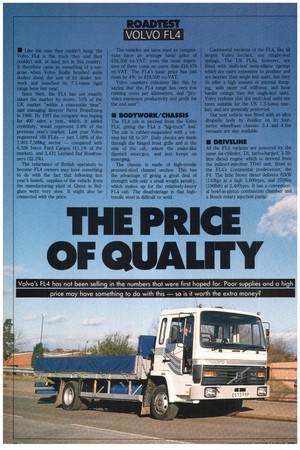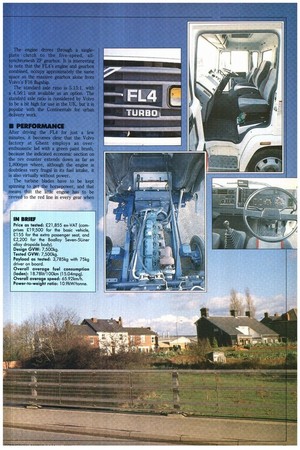in Like the man they couldn't hang, the Volvo FL4
Page 36

Page 37

Page 38

If you've noticed an error in this article please click here to report it so we can fix it.
is the truck they said they couldn't sell, at least not in this country. It therefore came as something of a surprise when Volvo finally brushed aside doubts about the size of its dealer network and launched its 7.5-tonne rigid range here last year.
Since then, the FL4 has not exactly taken the market by storm: 10% of the UK market "within a reasonable time", said managing director Bernt Brandtzaeg in 1986. By 1987 the company was hoping for 400 sales a year, which, it added contritely, would represent 2.8% of the previous year's market. Last year Volvo registered 166 Fl.As — just 1.08% of the 7,401-7,500kg sector — compared with 6,338 lveco Ford Cargos (41.1% of the market), and 3,431 Leyland Daf Roadrunners (22.2%).
The reluctance of British operators to become FL4 owners may have something to do with the fact that following last year's launch, supplies of the vehicle from the manufacturing plant at Ghent in Belgium were very slow. It might also be connected with the price. The vehicles we have used as comparisons have an average basic price of £16,358 ex-VAT; even the most expensive of them costs no more than .16.470 ex-VAT. The FL4's basic price has just risen by 4%, to £19,500 ex-VAT.
Volvo counters criticisms like this by saying that the FL4 range has very low running costs per kilometere, and "provides maximum productivity and profit for the end user".
• BODYWORK/CHASSIS
The FL4 cab is pinched from the Volvo FL6, giving the FL4 a "big-truck" feel. The cab is rubber-suspended with a torsion bar tilt to 55°. Daily checks are made through the hinged front grille and at the side of the cab, where the snake-like dipstick emerges, and just keeps on emerging.
The chassis is made of high-tensile pressed-steel channel section. This has the advantage of giving a great deal of strength with only a small weight penalty, which makes up for the relatively-heavy FL4 cab. The disadvantage is that hightensile steel is difficult to weld. Continental versions of the FL4, like all larger Volvo lorries, use single-leaf springs. The UK FL4s, however, are fitted with multi-leaf semi-elliptic springs which are more expensive to produce and are heavier than single leaf units, but they do offer a high amount of internal damping, with more roll stiffness, and have harder ratings than the single-leaf units. Volvo reckons that the multi-leaf units are more suitable for the UK 7.5-tonne market, and are generally preferred.
Our test vehicle was fitted with an alloy dropside body by BoaHoy on its fourmetre wheelbase chassis: 3.4 and 4.6m versions are also available.
• DRIVELINE
All the FL4 variants are powered by the same six-cylinder, DI, turbocharged, 3.59litre diesel engine which is derived from the indirect-injection TD40 unit, fitted to the FL4's Continental predecessor, the F4. The little blown diesel delivers 82kW. (110hp) at a high 3,600rpm, and 270Nnr (1991bft) at 2,400rpm. It has a conventional bowl-in-piston combustion chamber and a Bosch rotary injection pump. e engine drives through a singleate clutch to the five-speed, allchromesh ZF gearbox. It is interesting note that the FL4's engine and gearbox mbined, occupy approximately the same ace as the massive gearbox alone from olvo's F16 flagship.
The standard axle ratio is 5.13:1, with a 4.56:1 unit available as an option. The standard axle ratio is considered by Volvo to be a bit high for use in the UK, but it is popular with the Continentals for urban
PERFORMANCE
Inlivery work.
Liter driving the FL4 for just a few utes, it becomes clear that the Volvo ctory at Ghent employs an over'enthusiastic lad with a green paint brush, because the indicated economic section on the rev counter extends down as far as ,800rpm where, although the engine is oubtless very frugal in its fuel intake, it also virtually without power.
The turbine blades have to be kept inning to get the horsepower, and that_ . means that the little engine has to revved to the red line in every gear w driving on any surface other than a billiard table. If the engine speed is allowed to drop below around 2,000rpm, the power disappears into the Slough of Despond from which it never fully recovers without a change of gear.
The gearchange, however, provides little encouragment for this move, especially the first-to-second change, which can be very obstructive. This might encourage a driver to pull away in second gear, but the lack of low-down power means that letting out the no-slip clutch causes the engine revs to plummet. The vehicle then lurches forward with the speed of a striking slug, straight into the path of oncoming traffic which was out of sight when the manoeuvre first started.
This may all sound a bit unforgiving, but the deficiencies of the driveline are at their worst if the famed laid-back Volvo driving style is used. To make the best use of the FL4 one has almost to grab it by the scruff of the neck and hurl it up the road. Fast gearchanges, holding onto the gears, never letting the engine labour, and never driving on the brakes allow the best characteristics of the engine to shine through.
Most noticeable among these virtues is its smooth refinement. Even at peak revs the engine sounds like a turbine, with little perceptible vibration or noise.
• FUEL CONSUMPTION
Our test vehicle was fitted with the 5.13:1 differential that allowed a top speed of 100km/h (62mph) at the 3,600rpm red line in fifth gear, and this was useful for A-road driving, where the FL4 could be left in fifth for much of the time.
On the motorway, however, the fuel consumption would clearly be better with the optional 4.56:1 differential, which would also allow a higher top speed. As it is a no-cost option, Volvo will be recommending it to operators, contemplating regular motorway work.
The Volvo's fuel consumption over our distribution route was disappointing, although it clearly wasn't helped by the strong winds encountered during the day. These also affected the acceleration tests.
The next day the weather was a lot better, and the lorry yomped round our slightly modified Welsh route to return 18.81it/100km (15mpg) at 65.9km/h (40.9mph). This is certainly not disgraceful, but the Belgian-built product will have to go some way to beat the Iveco Ford Cargo 0811 in the comparison charts, or the Mercedes 809 that achieved 15.651it/ 100km (18.05mpg) round our test route with its 66kW engine.
• BRAKING
The braking system on the FL4 is identical to that of the new disc-braked Ford Cargos: air-over-hydraulic with separate circuits for the front and rear axles, and the same sized discs for each wheel.
We had some trouble with the system when we tested it in the Cargo (CM 6 June 1987), but the Volvo had none of the cross-axle braking imbalances apparent on the Cargo, and it pulled up perfectly straight with a peak deceleration of 0.8g.
Retardation is superbly progressive, and although hard braking causes the cab to descend like a lift as the springs compress to the bump stops, it remains easy to control.
The suspension has a fair degree of travel on its multileaf springs, but it swallows bumps without giving too soft a ride. The damping effect of the springs does reduce body roll, and the vehicle will hold on tenaciously even on the worst corners.
• INTERIOR
The FL4 is easily recognised as the lorry with the continuously-flashing indicator. This is because the repeater unit is inaudible, and the faint warning light on the dashboard is obscured by the steering wheel for drivers of a certain height.
Like Leyland Dal's Roadrunner cab, the Volvo cab lets in water, and our test vehicle's electrics were upset by the rain that found a way past its 'rudimentary defences.
The controls are simple enough; we particularly like the no-nonsense heater controls and the heated rearview mirrors that come as standard.
We were not as impressed by the seating position that tends to leave the driver slipping down the seat squab towards the footwell. This is irritating at first, can be very uncomfortable on a long journey, and makes a mockery of Volvo's reputed "oarlike" driving comfort.
• SUMMARY
A shopping trip to Bond Street or Knightsbridge in London will confirm the suspicion that good quality costs a lot of money. The Volvo FL4 is undoubtedly a good quality product in its finish, and its feel, but it has few tangible advantages over Anglo-Dutch and Anglo-Italian rivals.
It has a small, hard-worked engine; a "difficult" gearchange; superb brakes; and a big, roomy, but ugly cab. It isn't particularly economical or fast — but above all, it costs almost 2,000 more than its rivals.
The Swedes are pushing the little truck hard to operators in this country, but have not won the sales they hoped for. Perhaps Volvo will, to its cost, soon discover the real cost of quality.
El by Andrew English




























































































